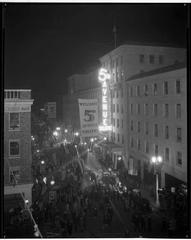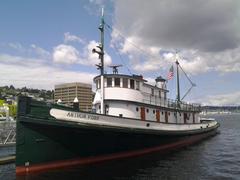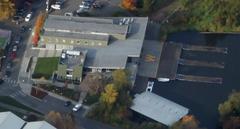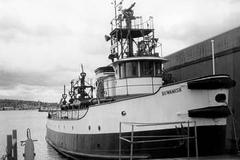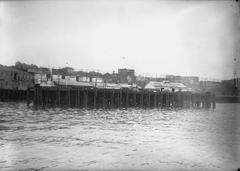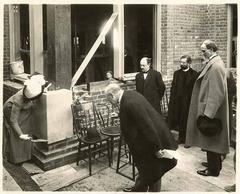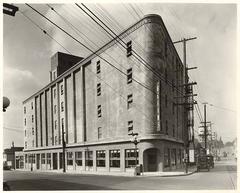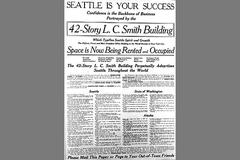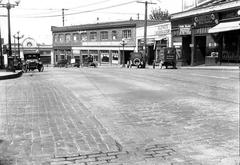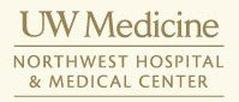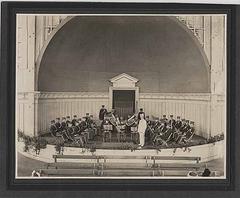
St. Mark’s Episcopal Cathedral Seattle: Visiting Hours, Tickets, Historical Significance & Travel Guide
Date: 04/07/2025
Introduction
St. Mark’s Episcopal Cathedral, perched atop Seattle’s Capitol Hill, is a profound symbol of the city’s historical, architectural, and spiritual legacy. Since its founding in 1889, the cathedral has weathered periods of prosperity and hardship, growing into a fortress-like neo-Byzantine structure renowned for its striking concrete exterior, luminous stained glass, and exceptional acoustics. More than a place of worship, St. Mark’s is a center for community engagement, cultural enrichment, and social justice, reflecting the inclusive and progressive ethos of Seattle itself (Saint Mark’s Cathedral History, Capitol Hill Seattle, Episcopal Diocese of Olympia).
This comprehensive guide covers everything you need to plan your visit: detailed historical background, architectural highlights, practical visitor information, accessibility, nearby attractions, and essential travel tips. Whether you’re drawn by the serenity of the weekly Compline service, a passion for architecture, or a desire to experience Seattle’s vibrant community spirit, St. Mark’s Cathedral offers a memorable destination for all.
Table of Contents
- History and Architectural Evolution
- Architectural Features & Renovations
- Role in Community & Social Justice
- Visitor Information
- Worship, Music, & Events
- Nearby Attractions & Travel Tips
- FAQs
- Conclusion & Resources
History and Architectural Evolution
Early Foundations (1889–1926)
St. Mark’s Episcopal Cathedral originated in 1889, with its first congregation gathering in downtown Seattle. Rapid growth led to the construction of a larger church by 1897 on First Hill, and by 1910, St. Mark’s was named the cathedral for the newly established Episcopal Diocese of Olympia (Saint Mark’s Cathedral History, PCAD Building History).
Vision & Construction (1926–1931)
In 1926, the cathedral’s leaders commissioned San Francisco architects John Bakewell Jr. and Arthur Brown Jr. to design an ambitious neo-Byzantine edifice, featuring grand towers and ornate finishes (Capitol Hill Seattle). Construction began in 1928, but the Great Depression soon forced a dramatic reduction in scope. By its 1931 dedication, only the core concrete structure—nicknamed “the Holy Box”—was complete (Wikipedia, Sacred Destinations, HistoryLink).
Hardship & Wartime Use (1931–1945)
Financial difficulties continued through the 1930s, leading to foreclosure in 1941. The U.S. Army leased the cathedral during World War II for anti-aircraft training (1943–1945), leaving murals in the crypt as a testament to its temporary military role (PCAD Building History, Wikipedia).
Revival & Community (1945–Present)
After the war, the congregation rallied to reclaim and restore the cathedral, burning the paid mortgage on Palm Sunday, 1947 (HistoryLink). Dean John C. Leffler (from 1952) revitalized the parish, expanding its music program and social outreach (Saint Mark’s Cathedral History). Ongoing renovations, notably those by Olson Kundig since 1997, have completed the limestone exterior, improved accessibility, and preserved the cathedral’s unique architectural vision (olsonkundig.com).
Architectural Features & Renovations
The cathedral’s exterior is characterized by its monumental, fortress-like concrete walls and columns, with recent renovations adding Indiana limestone cladding and a prominent Celtic cross (olsonkundig.com). The interior features a soaring wood-beam ceiling, a vast nave, and understated arched windows that cast colorful light patterns throughout the day (seattlemet.com).
Key artistic highlights include:
- Glass Reredos (Altar Screen): Designed by Olson Kundig and Ed Carpenter, mirroring the east façade’s cross.
- Stations of the Cross: Sculptures by Virginia Maksymowicz.
- Pipe Organs: Including the renowned Flentrop organ used in concerts (Sacred Destinations).
Energy efficiency and accessibility have been prioritized through new windows, an elevator, and expanded terraces (olsonkundig.com).
Role in Community & Social Justice
St. Mark’s is deeply engaged in social and environmental justice, reflected in its ministries for affordable housing, food security, and environmental stewardship (Saint Mark’s Annual Report 2024-25, p. 53). It acknowledges its presence on Duwamish land and welcomes all, regardless of background or identity (Saint Mark’s Cathedral). Adaptive reuse of campus buildings has provided space for a women’s shelter and plans for affordable housing (julieroys.com).
The cathedral also fosters interfaith dialogue, contemplative prayer, and lifelong learning through its Wisdom School and Center for Spirituality and Action (Wisdom School).
Visitor Information
Visiting Hours
- Monday–Saturday: 9:00 a.m. – 5:00 p.m.
- Sunday: 8:00 a.m. – 7:00 p.m.
- Special Note: Hours may vary on holidays and during special events. Always check the official website or event calendar before visiting.
Admission & Tickets
- General Admission: Free (donations welcome)
- Concerts & Special Events: Tickets may be required; purchase online (usually via Eventbrite) or at the door.
Guided Tours
- Monthly Tours: Typically offered on the last Sunday after the 11 a.m. service.
- Seasonal/By Appointment: Additional tours may be available; check the tours page or contact the office.
Accessibility
- Wheelchair Access: Elevator to all floors, accessible restrooms, and entrances.
- Assistive Listening: Devices available upon request.
- Service Animals: Welcomed throughout the facility.
Parking & Transportation
- Parking: Onsite lot (limited), nearby street parking. Parking fills quickly for large events.
- Public Transit: Served by Seattle Metro bus routes; a short walk from Capitol Hill Light Rail Station.
- Bike & Pedestrian Access: Easily accessible by foot or bicycle from surrounding neighborhoods.
Photography
- Personal Use: Allowed during visiting hours (no flash/tripods during services).
- Commercial Use: By prior arrangement.
Worship, Music, & Events
Worship Services
- Sunday Eucharist: 8 a.m. (Thomsen Chapel), 9 a.m. & 11 a.m. (Nave; 11 a.m. service is livestreamed)
- Choral Evensong: First Sunday monthly (Oct–June) at 4:30 p.m.
- Compline: Every Sunday at 9:30 p.m., sung by the Compline Choir and broadcast (Compline Podcast)
- Contemplative Eucharist: Sunday evenings, focusing on silence and reflection
Music & Arts
- Annual Music Series: Features local and international artists (Music Series)
- Organ Concerts: Informal mini-concerts and Q&A sessions
- Special Events: Community concerts, art installations, and interfaith gatherings
Community Activities
- Cathedral Yoga: Mondays at 6:30 p.m. (donation-based, all levels)
- Forums & Wellness Events: Social justice forums, contemplative prayer, and more
For the latest schedule, consult the event calendar.
Nearby Attractions & Travel Tips
- Volunteer Park & Conservatory: Adjacent green space with gardens and walking trails
- Seattle Asian Art Museum: Located within Volunteer Park
- Capitol Hill: Vibrant district with dining, shops, and nightlife
- St. Mark’s Greenbelt: Wooded area offering scenic views of Lake Union and downtown
Travel Tips:
- Arrive early for popular events (such as Compline) for the best seating.
- Use public transit or rideshare to avoid parking challenges, especially on Sundays.
- Explore the cathedral’s gift shop for books and mementos.
FAQs
Q: What are the cathedral’s visiting hours?
A: Monday–Saturday 9:00 a.m.–5:00 p.m.; Sunday 8:00 a.m.–7:00 p.m. Check here for updates.
Q: Is there an admission fee?
A: Admission is free; donations are appreciated.
Q: Are guided tours available?
A: Yes, monthly after the 11 a.m. service and by appointment.
Q: Is the cathedral wheelchair accessible?
A: Yes, with elevators, ramps, and accessible restrooms.
Q: Can I take photos inside?
A: Yes, for personal use during visiting hours; restrictions apply during services.
Q: How do I get tickets for concerts?
A: Purchase online via Eventbrite or at the door.
Q: Is parking available?
A: Limited onsite; street parking and public transit recommended for busy events.
Conclusion & Resources
St. Mark’s Episcopal Cathedral is more than an architectural marvel; it is a living testament to Seattle’s history, artistry, and inclusive community spirit. From its resilient beginnings and unfinished grandeur to its vibrant worship, music, and outreach programs, the cathedral welcomes visitors of all backgrounds for reflection, inspiration, and connection.
Plan your visit today:
- Check saintmarks.org for up-to-date hours, events, and tour information.
- Download the Audiala app for curated audio guides and stories.
- Follow St. Mark’s on social media for event updates and community news.
Contact: 206-323-0300 | [email protected]
References
- Saint Mark’s Cathedral History
- Capitol Hill Seattle
- Episcopal Diocese of Olympia
- Wikipedia
- HistoryLink
- Sacred Destinations
- Olson Kundig
- Seattle Met
- Julieroys.com
- Episcopal News Service
- Saint Mark’s Annual Report 2024-25
- Wisdom School


